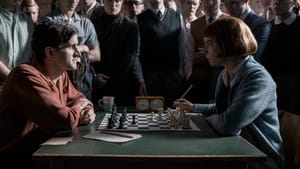Stay in the Loop
BSR publishes on a weekly schedule, with an email newsletter every Wednesday and Thursday morning. There’s no paywall, and subscribing is always free.
A beautiful game
Netflix presents ‘The Queen's Gambit’

Netflix's The Queen's Gambit, a limited series period drama that premiered in October, became, according to Netflix, its most-watched scripted miniseries after only one month of viewing. And for good reason. Based on Walter Tevis's 1983 novel of the same name, the series follows a female chess prodigy’s journey from orphaned child to internationally respected champion.
A gripping story
Show creators Scott Frank (writer and director) and Allan Scott deliver a gripping story, hooking viewers from the first scene introducing Beth Harmon (Anya Taylor-Joy). Orphaned at age 9, Harmon becomes addicted to tranquilizers that her orphanage distributes as an obligatory daily dose of “vitamins.” Harmon continues to struggle with drug and alcohol dependency into adulthood, as she develops into a complex, self-destructive, confident chess genius.
The orphanage's janitor introduces Harmon to the game of chess and is amazed at how quickly she becomes unbeatable. Harmon can see the whole game in her head and spends hours practicing different chess strategies by visualizing a chessboard on her bedroom ceiling at night.
In a nuanced physical performance, Taylor-Joy makes a commanding storyteller who elicits unyielding empathy for Harmon’s tumultuous journey in ways both spoken and unspoken. The dramatic tone and stellar cinematography are giving chess (never the height of cool in mainstream culture) a popular resurgence.
Women in chess, then and now
The series highlights sexism in the chess world during the 1950s and 60s, an issue that still affects the game (in my own experience). As a young student who didn’t excel in math and science, I was made to believe that I didn’t hold the intellectual capabilities for critical, strategic thinking. I became fascinated with chess as a child, appreciating how the game activated my brain in a way that made me feel smart, calculating, and powerful. I owned a magnetic travel-size chess set that I brought everywhere, pressing my family to play during long car rides.
As an adult struggling to find friends who enjoyed chess, I began to play in city parks with strangers and attended weekly chess nights in local community centers. Almost always the only woman there, I eventually abandoned playing in those spaces because of the sexism I experienced. Male opponents were condescending and belittling before a game even began, with players either patronizingly calling me “sweetheart” or lacking the social skills to interact with a woman in what is normally a male-dominated space.
In my mid-twenties, living in San Francisco, I discovered an all-female/nonbinary chess club at the Mechanics' Institute, which houses the oldest continuously operating chess club in the United States. The club met weekly on Sundays, and for years it was my church, becoming the first chess community I felt comfortable enough to grow and play in. The group consisted entirely of retired women whom I might never have met without our shared love of chess.

During one Sunday match, I was engrossed in a game with a lovely woman in her eighties. A man suddenly popped his head through the door and addressed the room, saying, “How are we doing today, ladies?” My opponent turned around and replied, “Excuse me, we are in the middle of a match.” Bewildered, the man apologized and left.
“I just can’t stand arrogance,” she told me before returning her attention to our match. The interaction left me stunned and grateful. Absent her example, I would have paused my intense train of thought to begrudgingly greet the man, without considering how a woman would never interrupt a chess room filled with male players in the same manner.
A liberating rigor
In The Queen’s Gambit, Harmon describes chess as a beautiful game in which the board is an “entire world in just 64 squares. I feel safe in it. I can control it, I can dominate it, and it’s predictable. So if I get hurt, I only have myself to blame.”
I can relate to that surprising sense of liberation in a game that demands a high level of detail and control, where every single move, decision, and action has a consequence, challenging players to be analytical, clever, and lethal all at once. Each chess match is an education, an opportunity to use knowledge gained through both triumphs and losses as a guide for future play, and to me, each ready chessboard represents a clean slate.
Nowadays, most of my chess playing is on apps, but The Queen's Gambit has reinvigorated my passion for the game. I’m grateful if the show’s success drives a new wave of chess fanatics across the globe, and allows more people to see the magic found in just 64 squares.
Image description: A still from The Queen’s Gambit shows actors Harry Melling and Anya Taylor-Joy sitting across from each other at a table with a chess game. They stare at each other challengingly, and a crowd of men watch in the background.
Image description: Writer Christina Anthony and her friend, a young man in a black baseball hat and a tattooed arm, sit opposite each other on the living-room floor. A chess game is on the coffee table between them.
What, When, Where
The Queen’s Gambit is available to stream on Netflix.
Sign up for our newsletter
All of the week's new articles, all in one place. Sign up for the free weekly BSR newsletters, and don't miss a conversation.

 Christina Anthony
Christina Anthony